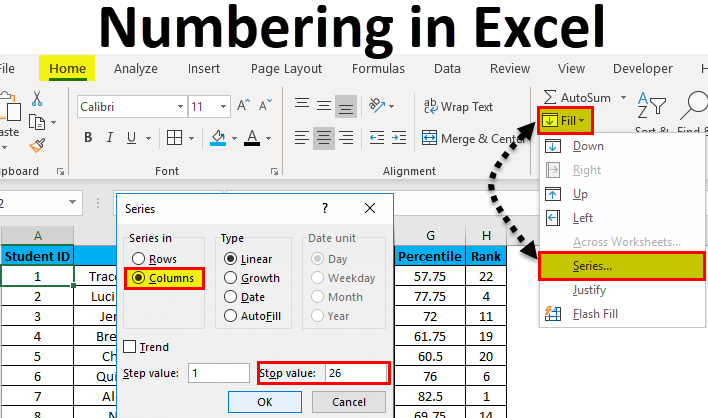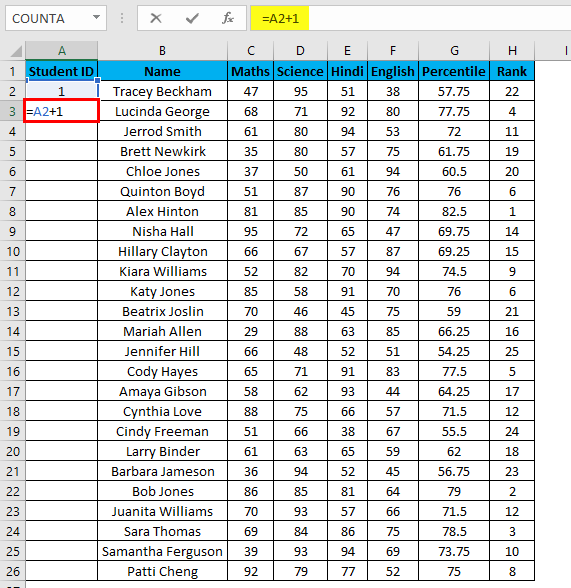

- #EXCEL AUTO GENERATE NUMBER SEQUENCE GENERATOR#
- #EXCEL AUTO GENERATE NUMBER SEQUENCE FULL#
- #EXCEL AUTO GENERATE NUMBER SEQUENCE CODE#
Whenever the condition is True, the formula executes the COUNTIF portion.

There are three combined IF AND functions inside this formula.At first, select the cell range D5:D10 and type the following formula.In this section, we will use the COUNTIF function to create a number sequence based on a criterion, which is the brand name. Using COUNTIF Function to Create a Number Sequence in Excel Based on Criteria For the laptop, our number sequence continues, however, for the mobile phone, this counter resets to 1.ġ. There are two laptops and one mobile phone for that brand. In this dataset, notice there are three “Apple” in the Brand column. On the other hand, if there is a new entry, then the number sequence will start from 1. If there is a duplicate product and brand, then we will increment the number sequence. Our condition will be the brand name and product name. Moreover, we will change this a little bit in methods 2 and 3. To demonstrate our methods, we have selected a dataset with 3 columns consisting of “ Product”, “ Brand”, and “ Sequence”. 🎓 User-Friendly: A breeze for beginners and a powerful tool for experts.4 Handy Approaches to Create a Number Sequence in Excel Based on Criteria 📝 Seven Types of Drop-down Lists: Make data entry a breeze with drop-down lists of various features and types. 🗄️ Powerful Navigation Pane: Gain an advantage with the robust Column Manager, Worksheet Manager, and Custom Favorites.

📊 Customizable Charts and Reports: Access a broad variety of additional charts and generate insightful reports that tell a story. ⏱️ Efficient Batch Operations: Why put in extra effort when you can work smart? Import, export, combine, and tweak data in bulk with ease.

📈 Superior Data Processing: Merge cells, remove duplicates, and perform advanced data conversions – all without breaking a sweat! 🛠️ Over 300 Powerful Features: Kutools is packed with more than 300 advanced features, simplifying your work in over 1500 scenarios. Streamline intricate tasks and glide through your data like a pro. Ready to supercharge your Excel tasks? Harness the power of Kutools for Excel - your ultimate time-saving tool. Transform Hours into Minutes with Kutools for Excel! Click to know more about this Insert Sequence Number feature of Kutools for Excel No matter in which workbook you apply this Insert Sequence Number feature, it will generate an invoice number that is 1 bigger than the last time you apply this feature. Keep the new created Sequence selected, and click the Fill Range button, and then click the Close button. of digits box, specify the digits, such as 6 ģ. (4) In the Start Number box enter the beginning number of your invoice number, such as 10000 or 1 (3) In the Prefix (optional) box, enter you company name or other text you will show at the begging of invoice number (1) In the Sequence name box enter a name for the new sequence name, such as Invoice Number. In the Insert Sequence Number dialog box, click the New button, and then in the expanding Sequence number editing area please do as follows (see above screenshot): Select the cell you will get invoice number, and then click the Kutools > Insert > Insert Sequence Number.Ģ.
#EXCEL AUTO GENERATE NUMBER SEQUENCE FULL#
Full feature free trial 30-day, no credit card required! Get It Nowġ. Kutools for Excel- Includes more than 300 handy tools for Excel. In addition to make whole numbers as invoice number, we can verify our invoice numbers with following formulas: No. Note: Change the D2 to the specified cell in which you entered the beginning number of invoice number in Step 2.ĥ.
#EXCEL AUTO GENERATE NUMBER SEQUENCE GENERATOR#
VBA: Voice Number Generator Private Sub Workbook_Open()
#EXCEL AUTO GENERATE NUMBER SEQUENCE CODE#
Paste the following code into the opening window. Note: In our case, we double click the ThisWorkbook under the VBAProject (Book1).Ĥ. Open the Microsoft Visual Basic for Applications dialog box with pressing the Alt + F11 keys simultaneously, then expand the VBAProject (current workbook), and double click the ThisWorkbook.


 0 kommentar(er)
0 kommentar(er)
